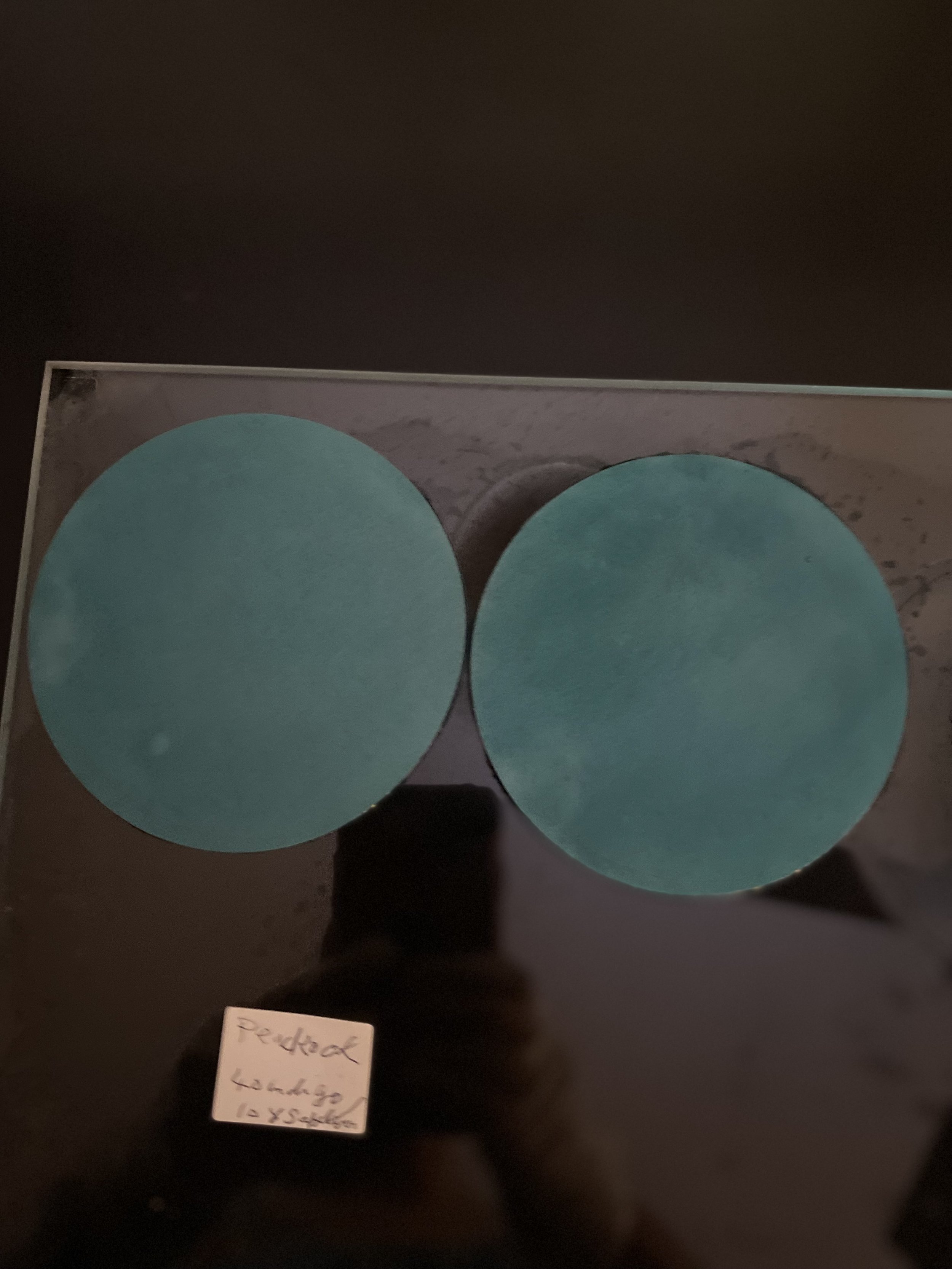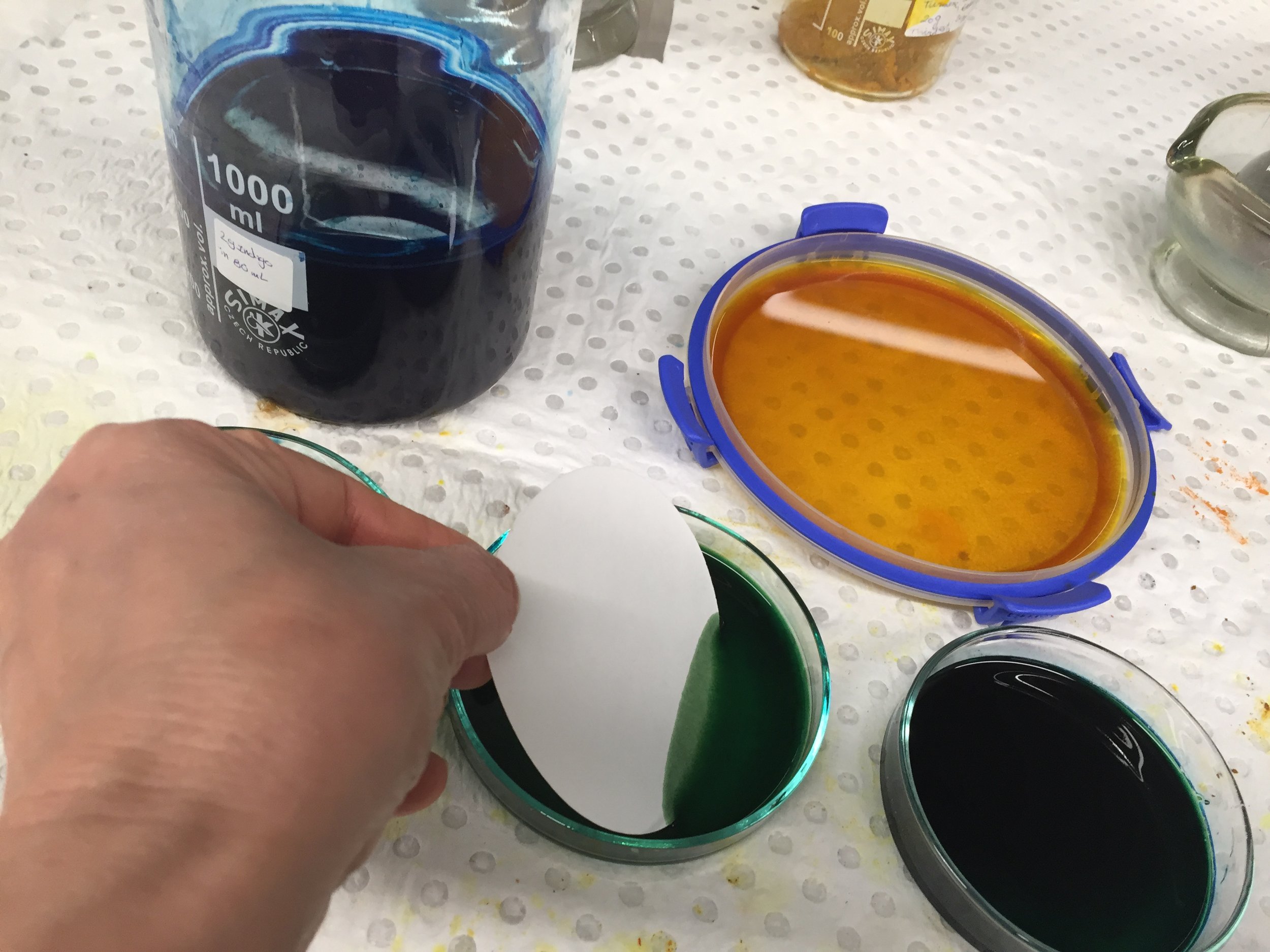PEACOCK GREEN (SABZ-E TĀVUSI), GRACEFUL GREEN (SABZ-E LATIF), CHINA GREEN/JADE (CHINI), AND TULIP GREEN (LALEH)
Peacock Green (sabz-e tāvusi)
The recipe in Majmu’at al-sanaye (1005 A.H. /1596 A.D) describe a technique to achieve peacock green (sabz-e tāvusi), graceful green (sabz-e latif), China Green/Jade (chini) in different concentration of the mixture of blue indigo and yellow safflower.
Peacock green (sabz-e tāvusi) shade is recommended to be made with a mixture of yellow safflower extract and extract of blue indigo in ratio of one to four:
رنگ طاوسی چهار حصه آب رنگک ، یک حصه زردآب
To achieve a green peacock (tāvusi) color, combine one part yellow safflower extract with four parts of blue indigo extract.
Graceful Green (sabz-e latif)
Another green shade of colour in the recipe is called graceful green (sabz-e latif) which is a mixture of indigo and yellow safflower in the ratio of four to two:
رنگ دو دانگ زردآب و چهار دانگ نیل پخته سبز لطیف
To create a delicate green color (sabz-e latif), mix two parts yellow safflower extract with four parts indigo dye.
China Green/Jade (chini)
Another green shade of colour called chini (China green/jade) is mentioned in the recipe, advising to mix indigo and yellow safflower in the ratio of two to four:
رنگ چینی چهار دانگ زردآب و دو دانگ نیل پخته چینی آید
The hue of China Green (sabz-e chini) emerges from a blend of four parts yellow safflower and two parts indigo dye.
The other source that mentiones China green (sabz-e chini) is described in Resāleh-ye Joharrieh (837 AH/1433 A.D.) and Resāleh dar Maʿrefat-e Kāḡaḏ-e Alvān (19th century). In the recipe the same mixture of yellow and blue is recommended to obtain three different green shades of colours out of the dye mixture namely China green jade (sabz-e chini), tulip green (laleh) and iris green (susani) which is mentioned below in detail.
Tulip Green (laleh)
Another color mentioned in Persian historical recipes is the shade of green called tulip (laleh), resembling the color of the spring green tulip flower. In Resāleh-ye Joharrieh (837 AH/1433 A.D.) and Resāleh dar Maʿrefat-e Kāḡaḏ-e Alvān (19th century C.E.), there is a recipe that describes how to make iris green (sabze susanī) with a mixture of yellow and blue, along with other green shades of colors, namely tulip (laleh) and China green (sabze chini), referring to jade color in the same mixture. These are lighter greens compared to iris green (susani). First, the papers are dipped in blue indigo dye. To obtain chini, the paper is removed from the mixture when the other papers are still in the dye. After a while, the next paper is removed to obtain green tulip (laleh). Finally, the last paper is removed when the color shade of green iris (susanī) is obtained. The longer the paper is dipped in the dye mixture, the closer it is to the green color shade of iris (susanī), the middle refers to tulip green (laleh), and the shortest time to green jade (chini) accordingly.
ده مثقال آب زرد صافی بر سر آب کبود بیندازد، و اول حکم چینی کند، و دوم حکم لاله، و سیم سوسن. باید که مراعات بجای آورد، یعنی رنگ سوسن بر دهد. و دو رنگ دیگر صبر کند.
Drop ten misqals of clear yellow extract into the blue dye. First, achieve the China Jade Green, then the Tulip Green, and finally the Iris Green. It must be noted that patience is required to obtain the Iris Green, which means waiting until the other two colors are achieved, starting with China Jade Green and then Tulip Green.
Peacock Green, Graceful Green, and China Green
Peacock Green
Graceful Green
China Green / Jade (chini)
Tulip Green
Experiment - Peacock Green (sabz-e tāvusi):
Mix yellow safflower extract and blue indigo dye in a ratio of 1:4 to create a peacock green dyebath. Dip the paper for an hour, then take it out and let it dry in the shade.
Experiment - Graceful Green (sabz-e latif):
Mix yellow safflower extract and blue indigo dye in a ratio of 2:4 to create a graceful green dyebath. Dip the paper for an hour, then take it out and let it dry in the shade.
Experiment - China Green Jade (chini):
Mix yellow safflower extract and blue indigo dye in a ratio of 4:2 to create a jade green dyebath. Dip the paper for an hour, then take it out and let it dry in the shade.
Experiment - Tulip Green (laleh):
Begin by pouring 50 ml of concentrated yellow safflower extract into the medium blue indigo dyebath. Dip three papers into the dyebath. First, remove the first paper after 10 minutes to achieve the green jade shade of color. Wait for 30 minutes and then remove the second paper from the dyebath to achieve the tulip green shade of color. After 30 minutes, finally, remove the last paper to achieve the Iris green shade of color.
Note: The timing to remove the papers can be varied depending on the concentration of the dyebath mixture and also the intensity of the color shades that are desired.
















